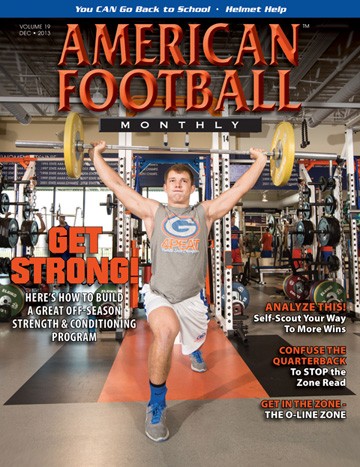Article CategoriesAFM Magazine
|
Speed Report: The Off-Season - Preparing for Advanced Level Trainingby: Dale BaskettFootball Speed Specialist © More from this issue When you begin the off-season with speed training, one of your major challenges will be organizing and periodizing your product. Obviously your periodization scheme stretches over many months. Your design is critical to the success of the progression you expect to gain during the year. One area that can be a little tricky and can have a distinct affect on your development for team speed is working with large numbers of players who are at two different levels of ability. My experience with this stems from putting the varsity and junior varsity groups together for training at the same time. The outcome favors neither group. The older kids have greater experience and are in need of advanced skill drills and formats that address their talent level. When you apply such procedures, the young learner has a limited foundational aptitude to handle the skill demands. So both lose and so does your program development. The same is true for the more experienced athlete who is in need of advanced implementation. The best solution for this dilemma is to divide and conquer. They both must be working apart. How you do this is, as stated earlier, tricky. I train someone else to work with base foundational application for the new kids and I handle the advanced group. This works well for all concerned. The system is set up so the younger kids who excel can move up to the advanced group as they show the skill as the off-season progresses. Itís a great incentive plan for those who want to achieve and it bolsters confidence. The other way is to divide the groups side by side Ė one group runs and then the other group runs. This is a tough project to pull off but Iíve done it many times. The division is really the quality route. The following thoughts and suggestions will hopefully help you construct your system to function adequately throughout the year. This article is designed to cover ideas that will help you formulate ways to assemble good sound training practicum that you can use for your program demands based on your individual situations. Hard start, softer finish. Easy start, harder finish. Take your pick but one thing is for sure Ė you must begin with fundamentals. This structure provides consistent development and secure control for athletic speed and movement. Football speed is different than linear sprint speed as we have discussed in past issues. It is truely a different training process and multi-dynamic in nature compared to linear speed work. This is why the foundation training for mechanical execution must be the first thing you address. The foundational principles applied will carry over to everything you do performance wise. Youíll also be reflecting back to the base structure often because of its relativity to human movement. Human movement has consistent biomechanical applications which are governing and must be applied right for maximal success. I had a call tonight from a dad who had a kid in high school who is a six foot, 180 pound linebacker playing varsity football. He runs a 5.1, 40 yard dash and his dad said he would like to see him run a 4.7, which would put him into the mix with the other backers on his team. My comment to him was how often as a linebacker does he run 40 yards when the ball is snapped? The answer was obvious. The prescription would be how quick is he and how well does he move laterally and change direction with mass velocity when the ball is snapped. Visualize what specificity speed is and apply it whenever necessary. Coach Baskett began his career as a football speed coach in 1979. During the last 34 years heís consulted and trained hundreds of coaches and thousands of athletes nationwide. In the last year he has worked directly with high schools in California, Texas, Minnesota, Kansas, and Pennsylvania. Over the last few years he has also consulted with Texas Tech, Ohio State, USC, University of Washington, and the University of Mount Union. You can reach him directly for more information or if you have specific questions on your training program. Coach Baskett is at dbspeedt@hotmail.com and 858-568-3751. |
|
| HOME |
MAGAZINE |
SUBSCRIBE | ONLINE COLUMNISTS | COACHING VIDEOS |
Copyright 2024, AmericanFootballMonthly.com
All Rights Reserved




